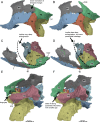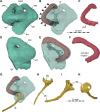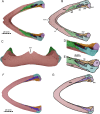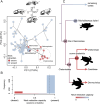New insights into the early morphological evolution of sea turtles by re-investigation of Nichollsemys baieri, a three-dimensionally preserved fossil stem chelonioid from the Campanian of Alberta, Canada
- PMID: 39006951
- PMCID: PMC11245440
- DOI: 10.1186/s13358-024-00323-8
New insights into the early morphological evolution of sea turtles by re-investigation of Nichollsemys baieri, a three-dimensionally preserved fossil stem chelonioid from the Campanian of Alberta, Canada
Abstract
The early evolution of Pan-Chelonioidea (sea turtles) is poorly understood. This is in part due to the rarity of undeformed skulls of definitive early stem chelonioids. In this work, we redescribe the holotype of Nichollsemys baieri using µCT scans and segmentations of the skull. This fossil is the best 3D preserved skull of any Campanian sea turtle, and includes partial "soft tissue" preservation. Nichollsemys is morphologically similar but clearly distinct from Toxochelys spp., and both show a mosaic of plesiomorphic and derived chelonioid features. The internal cranial anatomy documents the presence of derived characters in Nichollsemys baieri that are absent in Toxochelys spp., such as the loss of the epipterygoids and the rod-like shape of the rostrum basisphenoidale. Among the numerous plesiomorphic characters is the presence of a splenial bone, which was unnoticed before. An updated phylogenetic analysis retrieves Nichollsemys baieri as a non-protostegid early stem chelonioid in a slightly more crownward position than Toxochelys latiremis. Our phylogeny includes macrobaenids and protostegids as pan-chelonioids, and we find unorthodox results for dermochelyids. Thus, although Nichollsemys baieri provides important new insights into the early morphological evolution of sea turtles, much work remains to be done. As a completely 3D preserved specimen, we included Nichollsemys baieri into a recent landmark-based skull shape dataset of turtles. Morphospace analysis reveals an intermediate position between cryptodires and crown chelonioids. Based on these data, we also predict that Nichollsemys baieri was still capable of neck retraction, constraining the loss of this trait to more crownward pan-chelonioids.
Supplementary information: The online version contains supplementary material available at 10.1186/s13358-024-00323-8.
Keywords: CT scan; Evolution; Neck retraction; Pan-Chelonioidea; Phylogeny; Sea turtle.
© The Author(s) 2024.
Conflict of interest statement
Competing interestsThe authors declare no competing interests.
Figures















Similar articles
-
Anatomy of Rhinochelys pulchriceps (Protostegidae) and marine adaptation during the early evolution of chelonioids.PeerJ. 2019 May 1;7:e6811. doi: 10.7717/peerj.6811. eCollection 2019. PeerJ. 2019. PMID: 31106054 Free PMC article.
-
Comparative cranial morphology of the Late Cretaceous protostegid sea turtle Desmatochelys lowii.PeerJ. 2018 Dec 7;6:e5964. doi: 10.7717/peerj.5964. eCollection 2018. PeerJ. 2018. PMID: 30568851 Free PMC article.
-
A primitive protostegid from Australia and early sea turtle evolution.Biol Lett. 2006 Mar 22;2(1):116-9. doi: 10.1098/rsbl.2005.0406. Biol Lett. 2006. PMID: 17148342 Free PMC article.
-
A large non-marine turtle from the Upper Cretaceous of Alabama and a review of North American "Macrobaenids".Anat Rec (Hoboken). 2023 Jun;306(6):1411-1430. doi: 10.1002/ar.25054. Epub 2022 Aug 19. Anat Rec (Hoboken). 2023. PMID: 37158131 Review.
-
Salinity tolerances and use of saline environments by freshwater turtles: implications of sea level rise.Biol Rev Camb Philos Soc. 2018 Aug;93(3):1634-1648. doi: 10.1111/brv.12410. Epub 2018 Mar 25. Biol Rev Camb Philos Soc. 2018. PMID: 29575680 Review.
References
-
- Adams, D.C., Collyer, M.L. & Kaliontzopoulou, A. (2020). Geomorph: software for geometric morphometric analyses. R package version 3.2.1. Available via https://cran.r-project.org/package=geomorph
-
- Anquetin J. Reassessment of the phylogenetic interrelationships of basal turtles (Testudinata) Journal of Systematic Palaeontology. 2012;10(1):3–45. doi: 10.1080/14772019.2011.558928. - DOI
LinkOut - more resources
Full Text Sources
Research Materials
Miscellaneous
